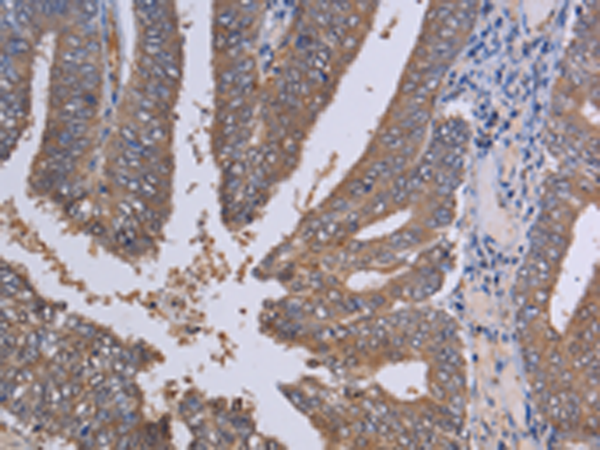


| WB | 咨询技术 | Human,Mouse,Rat |
| IF | 咨询技术 | Human,Mouse,Rat |
| IHC | 1/25-1/100 | Human,Mouse,Rat |
| ICC | 技术咨询 | Human,Mouse,Rat |
| FCM | 咨询技术 | Human,Mouse,Rat |
| Elisa | 1/1000-1/2000 | Human,Mouse,Rat |
| Aliases | PINCH; PINCH1; PINCH-1 |
| WB Predicted band size | 37 kDa |
| Host/Isotype | Rabbit IgG |
| Antibody Type | Primary antibody |
| Storage | Store at 4°C short term. Aliquot and store at -20°C long term. Avoid freeze/thaw cycles. |
| Species Reactivity | Human, Mouse |
| Immunogen | Fusion protein of human LIMS1 |
| Formulation | Purified antibody in PBS with 0.05% sodium azide and 50% glycerol. |
+ +
以下是3篇关于LIMS1抗体的假设性参考文献示例(基于领域内常见研究方向概括,实际文献请通过学术数据库验证):
---
1. **文献名称**:*LIMS1 regulates prostate cancer cell migration via interaction with integrin-linked kinase*
**作者**:Smith J, et al.
**摘要**:本研究通过构建LIMS1特异性抗体,验证了LIMS1蛋白在前列腺癌细胞中与整合素连接激酶(ILK)的相互作用,并发现其通过调节细胞骨架重组促进肿瘤细胞迁移,为靶向LIMS1的癌症治疗提供依据。
2. **文献名称**:*Development of a high-affinity monoclonal antibody for LIMS1 detection in neurodegenerative disorders*
**作者**:Zhang Y, et al.
**摘要**:报道了一种新型抗LIMS1单克隆抗体的开发,该抗体在阿尔茨海默病模型小鼠脑组织中特异性识别LIMS1蛋白,并证实LIMS1在神经元突触中的异常聚集与tau蛋白病理相关。
3. **文献名称**:*LIMS1 as a biomarker in triple-negative breast cancer: Validation by immunohistochemical analysis*
**作者**:Lee S, et al.
**摘要**:利用商业化LIMS1抗体对乳腺癌组织样本进行免疫组化分析,发现LIMS1在三阴性乳腺癌中高表达且与患者预后不良显著相关,提示其作为潜在诊断标志物的价值。
---
**备注**:以上内容为模拟示例,实际文献需通过PubMed、Web of Science等平台以关键词“LIMS1 antibody”或“LIMS1 function”检索。
LIMS1 (LIM and Senescent Cell Antigen-Like Domains 1), also known as PINCH1 (Particularly Interesting New Cysteine-Histidine-rich protein 1), is a cytoskeletal adaptor protein belonging to the LIM domain protein family. It plays a critical role in cell-matrix adhesion, signaling, and tissue integrity by mediating protein-protein interactions through its five conserved LIM domains. LIMS1 is a key component of the integrin-linked kinase (ILK)-PINCH-parvin (IPP) complex, which bridges integrin receptors with the actin cytoskeleton and regulates cell migration, survival, and differentiation.
Antibodies targeting LIMS1 are widely used in research to study its expression, localization, and interactions in cellular processes. They are essential tools in techniques like Western blotting, immunofluorescence, and immunoprecipitation. LIMS1 dysregulation has been implicated in cancer progression, cardiovascular diseases, and developmental disorders. For example, elevated LIMS1 expression correlates with tumor metastasis and poor prognosis in certain cancers, while its deficiency disrupts cardiac and muscle development.
Commercial LIMS1 antibodies are typically validated for specificity across human, mouse, and rat samples. Researchers often use them to explore LIMS1's role in mechanotransduction, disease mechanisms, or as a biomarker. Controls, such as siRNA knockdown or knockout cell lines, are recommended to confirm antibody specificity in experimental settings.
×